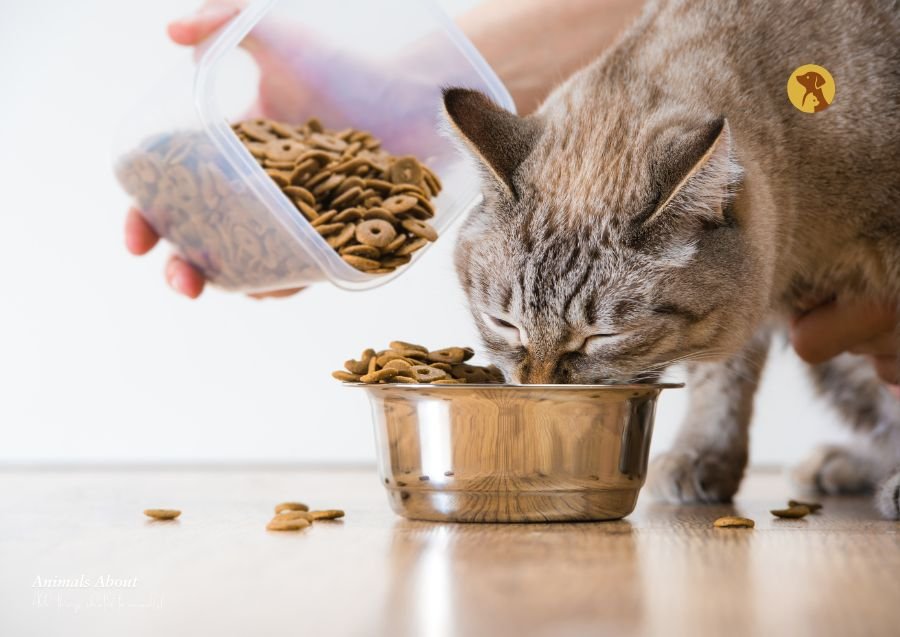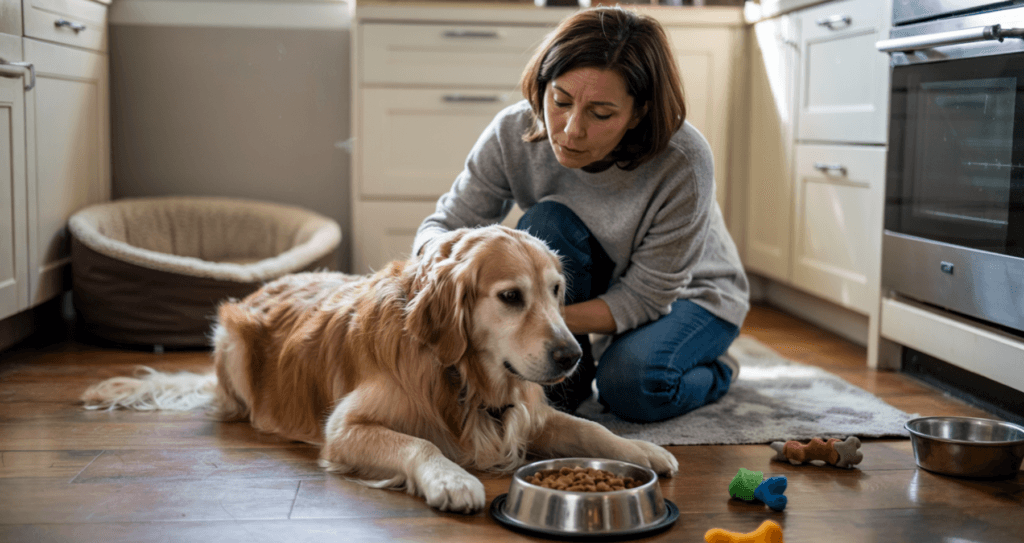Cat Daily Feeding Guide: Age & Weight Tips

Feeding your cat might seem simple, but when you dive into the details—age, weight, lifestyle, and food type it becomes clear that one size does not fit all. That’s why we’ve created this comprehensive cat daily feeding guide to help you understand how much food your cat needs daily and how to adjust portions over time. Whether you have a kitten bouncing off the walls, a chill adult lounging in the sun, or a wise old senior cat with more naps than zoomies, this guide covers everything you need to know. 🐾 Why You Need a Cat Daily Feeding Guide Every cat is unique, but their daily cat food portion plays a critical role in their health, behavior, and quality of life. Overfeeding can lead to obesity, diabetes, and heart disease, while underfeeding can cause malnutrition and lethargy. This vet-approved cat diet guide helps cat owners answer questions like: Let’s break it down! Kitten Feeding Guide (0–12 Months) Kittens grow fast. During their first year, their body weight can double or even triple in a matter of weeks. That’s why they need high-calorie, high-protein meals given frequently. 0–4 Weeks 4–8 Weeks 2–6 Months 6–12 Months Tip: Never feed adult cat food to kittens—it lacks the necessary nutrients for healthy development. Adult Cat Feeding Guide (1–7 Years) Adult cats usually do best with two balanced meals a day. The right amount depends on their weight, activity level, and whether they’re eating wet food, dry food, or a mix. Here’s a basic cat feeding chart by weight: Cat Weight Dry Food Wet Food 5 lbs (2.2 kg) 1/4 cup 3 oz 10 lbs (4.5 kg) 1/2 cup 6 oz 15 lbs (6.8 kg) 3/4 cup 9 oz Note: These are general guidelines. Use a cat calorie calculator or ask your vet for personalized advice. Senior Cat Food Amount (8+ Years) As cats age, they become less active and may develop health issues that affect their appetite or weight. Here’s what to keep in mind: Senior cats benefit from high-quality protein, omega-3s, and joint-supporting ingredients. How Often Should I Feed My Cat? Regular feeding times help your cat feel secure and promote healthy digestion. Age Group Feedings/Day Kitten (0–6 months) 3–4 small meals Young Cat (6–12 months) 2–3 meals Senior Cat 2–4 smaller meals Adult Cat 2 meals/day Cat Feeding Schedule Tips Here are a few helpful tips to create a cat feeding schedule that works: Consistency = healthier digestion and less begging behavior! Wet Food vs Dry Food for Cats Understanding the pros and cons of each helps with cat portion control and long-term health.
What to Do If My Dog Won’t Eat His Food Anymore

As pet parents, we know the joy of watching our furry friend gobble up their food with excitement—but what happens when that excitement vanishes overnight? If your dog suddenly refuses to eat, it can feel alarming. You’re left wondering, Is something wrong? Am I doing something differently? Don’t worry—you’re not alone. This comprehensive Dog Nutrition Guide will walk you through common causes, effective solutions, and how to know when to seek help from your vet. Why Has My Dog Stopped Eating? When your dog loses interest in food, it’s not just a minor inconvenience—it’s a clue. Appetite loss is one of the body’s first ways of signaling that something is off, whether it’s physical discomfort, emotional stress, or simply boredom with the same old kibble. Understanding the reason behind the behavior is the first step toward helping your pup regain their love for mealtime. 1. Picky Eating Habits Just like humans, dogs can develop finicky preferences—especially when they’re used to being spoiled with treats or table scraps. If your dog starts refusing his regular food but perks up for snacks, you may be dealing with a case of learned pickiness. It’s not necessarily a sign of illness, but it can quickly lead to bad eating habits and nutrition imbalances. 2. Switching Dog Food Brands Changing your dog’s food too suddenly can confuse their taste buds or upset their stomach. Imagine eating your favorite meal for weeks, only to be served something totally different without warning. For dogs, sudden brand switches or flavor changes can lead to digestive issues, rejection, or even anxiety around eating. Always make food transitions gradual to help your dog adjust. 3. Stress or Anxiety Dogs are sensitive creatures, and emotional stress can take a toll on their appetite just like it does for us. Have you recently moved homes, brought home a new baby or pet, or even gone back to work after spending more time at home? Changes in the environment or routine can cause your dog to feel unsettled—and that stress can lead to temporary food refusal. 4. Medical Issues When a dog stops eating, it might be a whisper from their body telling you something is wrong. Appetite loss may indicate dental pain, gastrointestinal problems, infection, or even organ dysfunction like liver or kidney issues. If your dog is still drinking water but avoiding food—or worse, showing signs of pain or vomiting—it’s best to consult your vet immediately. 5. Age and Energy Levels Your dog’s age plays a big role in their appetite, and what’s normal for a young pup may be very different for a senior dog. Puppies sometimes skip meals but stay energetic and playful, which is usually okay. On the other hand, older dogs may experience a natural drop in appetite due to slower metabolism, arthritis pain, or difficulty chewing. Understanding age-related eating patterns can help guide your next steps. When to Worry About a Dog Not Eating Skipping one meal now and then might not be serious, but consistent appetite loss is a red flag that shouldn’t be ignored. If your dog refuses to eat for more than 24 hours or shows signs of illness like vomiting, lethargy, or rapid weight loss, it’s time to get help. As loving pet owners, we sometimes wait and hope things will improve—but prompt action can make all the difference in a dog’s recovery. Key warning signs include: If your dog has lost their usual spark, don’t wait—listen to your instincts and book a vet visit. What to Do If Your Dog Won’t Eat If your dog is snubbing their food, don’t panic—there are several safe and simple ways to bring back their appetite. Rather than forcing them to eat or switching foods too often, start by creating a consistent feeding routine and trying small adjustments that stimulate their senses. 1. Stick to a Feeding Schedule Dogs thrive on routine—and when they know when to expect food, they’re more likely to eat it. Offer food at set times and remove it after 15–20 minutes if untouched. Avoid leaving food out all day, as this can lead to disinterest and grazing behavior that disrupts healthy eating habits. 2. Warm the Food Slightly A warm meal can work wonders, especially when a dog’s sense of smell needs a boost. Heating your dog’s food for just a few seconds can enhance its aroma, making it more tempting—just be sure it’s not too hot. 3. Add Low-Sodium Broth or Toppers Sometimes all it takes is a little flavor to get those tails wagging again. Adding a spoonful of low-sodium chicken broth, wet food, or a nutritious topper can make even dry kibble more enticing to a picky eater. 4. Try Hand-Feeding Hand-feeding your dog can restore trust and comfort, especially during illness or stress. If your dog is hesitant to approach their bowl, offering a few bites from your hand can ease their anxiety and help rebuild a positive association with mealtime. 5. Exercise Before Mealtime Just like humans, dogs are more likely to eat after a good workout. A short walk or play session can help stimulate your dog’s appetite and bring back that mealtime enthusiasm. Home Remedies for Picky Dogs Nature offers a few gentle, dog-friendly ingredients that can spark appetite without upsetting your dog’s tummy. When used correctly, these home remedies can support digestion and reintroduce variety without complicating your dog’s diet. These remedies are helpful tools, but always check with your vet first—especially if your dog has allergies or health conditions. Vet Advice for Dog Not Eating If you’ve tried everything and your dog still won’t eat, it’s time to turn to the experts. A vet can rule out serious conditions and offer tailored advice, including medications or prescription diets that support healing and appetite recovery. Vets may suggest: Remember: catching health problems early can prevent bigger issues down the road. Fixing Long-Term Dog Feeding Problems Helping your dog build healthy eating habits is a journey—but the rewards are lifelong. Whether your
